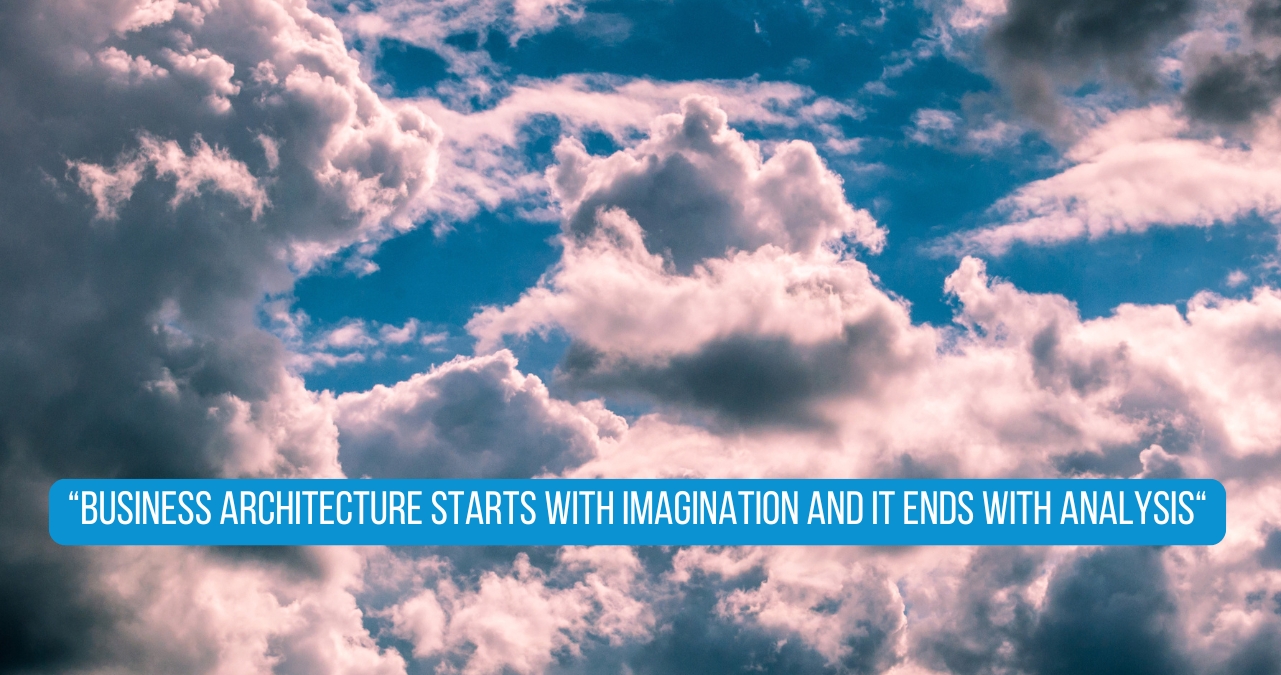It starts with imagination
In the world of business strategy and enterprise architecture, there’s a common debate: does business architecture truly start with imagination and end with analysis, or is it the other way around?
To delve into this question, we can at least architecturally explore the mental flow from conceptual dreaming to detailed planning and realisation. This journey is fundamental to business planning, product development, and business architecture.
Think about looking up at the sky, letting your thoughts wander, and dreaming of future possibilities. This is where strategy often begins—with “imagination”. This is mentally also, where Business Architecture starts.
Business architecture, according to Bulton, Ross and Zachman, is the structured description of the business knowledge relevant to designing, planning, analysing, operating, changing, And managing a business.
And among other objectives, one goal of Business Architecture is ultimately to identify non-redundant, reusable resources to be able to execute the business strategy. So when starting with imagination, ideas are unbound, conceptual, and forward-looking. They represent extensions of today’s realities into the future, embodying potential offerings and innovative tech options.
This phase, often characterized by uncommitted brainstorming, is crucial for capturing fleeting ideas before they slip away. From a Business Architecture perspective, this is the moment to document these early concepts, ensuring they are not lost. We often talk about making these ideas frictionless, as everyone in an organisation may dream and provide the idea.
Filtering and Designing the Business
Following the imaginative phase, the focus shifts to filtering and breaking down these ideas into tangible constructs. This involves exploring various options, designing potential business models, and assessing the company’s strengths and weaknesses relative to its ecosystem and where ideas may fit in. This phase is often more of an assessment, where the viability of the initial ideas is scrutinised. The goal is to identify which concepts can realistically be developed into successful ventures.
During this phase, businesses must be sharp about what they excel at and where others might have an advantage. It’s a period of evaluation, where imagination meets reality, and the feasibility of each idea is rigorously tested.
Once an idea passes the assessment phase, it enters the design stage. This involves developing logical flows and overall designs to transform the concept into a future business. At its best, this is the essence of business and enterprise architecture. Here, the focus is on creating detailed plans that consider risk, cost, and opportunities. This stage involves designing value streams based on core capabilities and developing solution designs that align with the overall business model. It’s a meticulous process of turning abstract ideas into concrete plans, ensuring that every aspect is aligned with the strategic vision.
Analysis & Planning
As a later set of activities, concepts are aligned and prioritised. This is where analysis plays a crucial role.
As the strategy moves into regular governance and management, alignment becomes a regular activity to ensure alignment and fact-based understanding of being in control. This phase highlights the alignment and misalignment. It provides the balance between investing in change and maintaining stability is maintained.
This phase involves monitoring the execution of the plans, assessing performance, and making necessary adjustments. It’s a cycle of continuous improvement, ensuring that the strategy remains relevant and effective in a dynamic business environment.
In summary
In summary, business architecture mentally starts with imagination—envisioning future possibilities—and ends with analysis—ensuring that those possibilities are viable and effective.
The journey from conceptual dreaming to detailed planning and analysis is essential for creating sustainable and successful businesses. By embracing this journey, organisations can innovate, adapt, and thrive in an ever-changing landscape.
This post outlines the logical journey from imagination to analysis, emphasising the importance of each phase in the strategic planning process. By understanding and embracing this journey, businesses can effectively innovate and adapt to achieve long-term success. This is something that can be supported by digital planning using modern SaaS-based services.
If you plan to work with business alignment and strategy, reach out for a meeting. We help companies start working with Enterprise and Business Architecture to see the big picture in strategic planning: Connect
Reach out today if you need to look into modern SaaS services for becoming digital savvy. With our focus on business architecture, Next-Insight establishes a single source of truth for decision-making from initial assessment to digital collaboration across large organisations. This is the practical onboarding of architectural planning. If tool interested, connect
Let’s connect if you require assistance in converting from a low-maturity into a future-oriented data-driven architecture practice. Book your free advisory session here.



